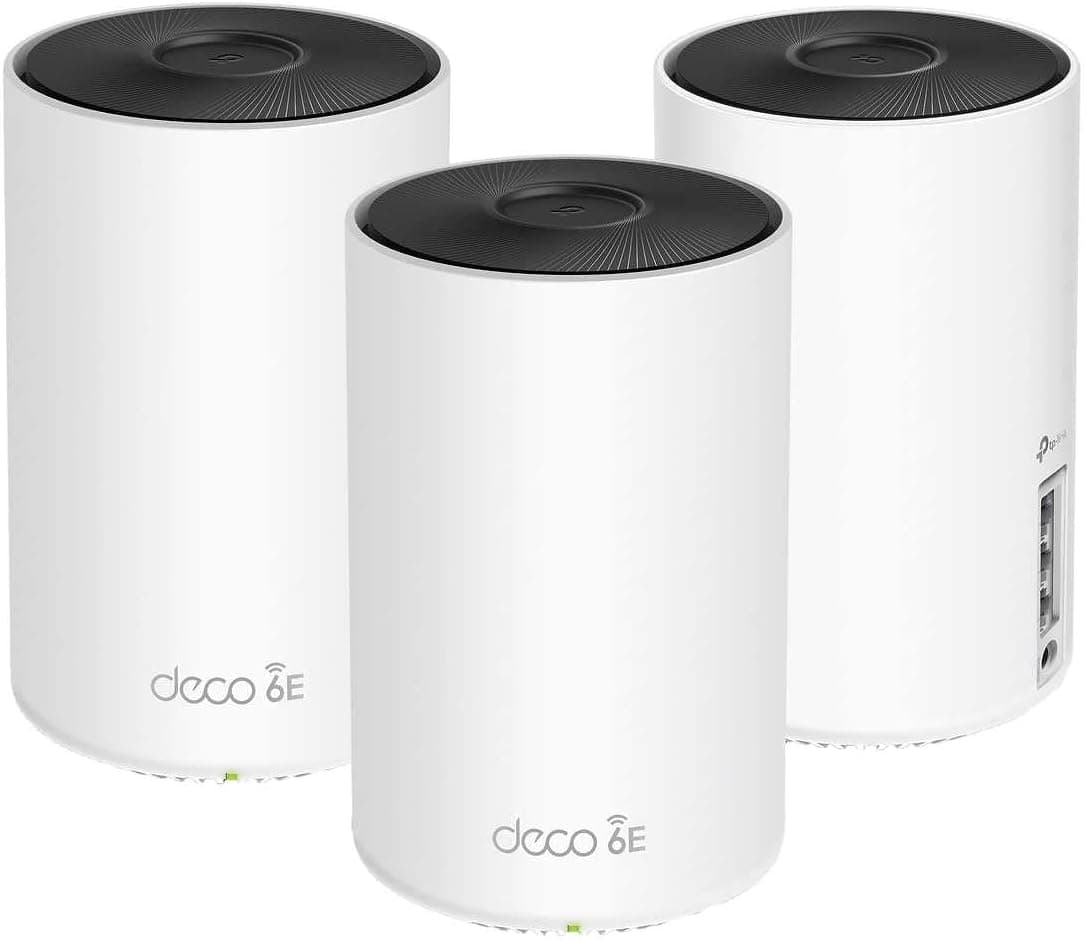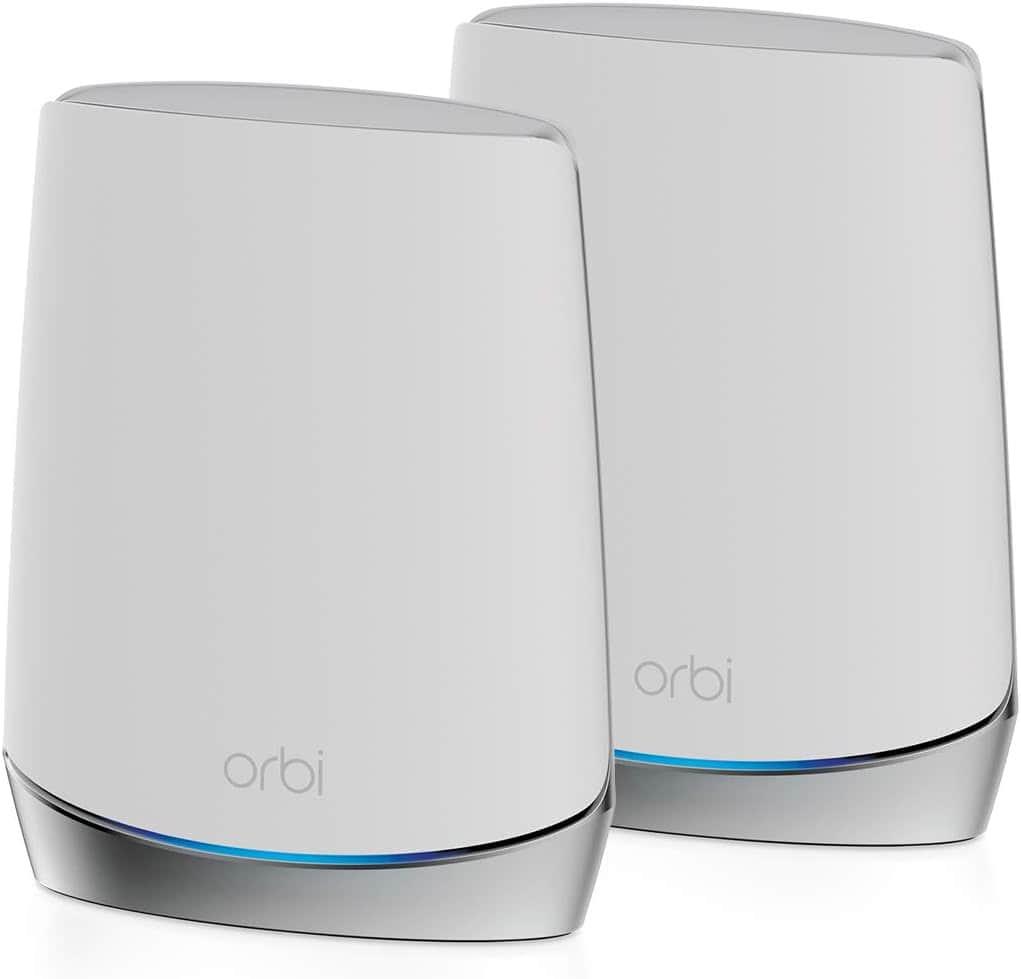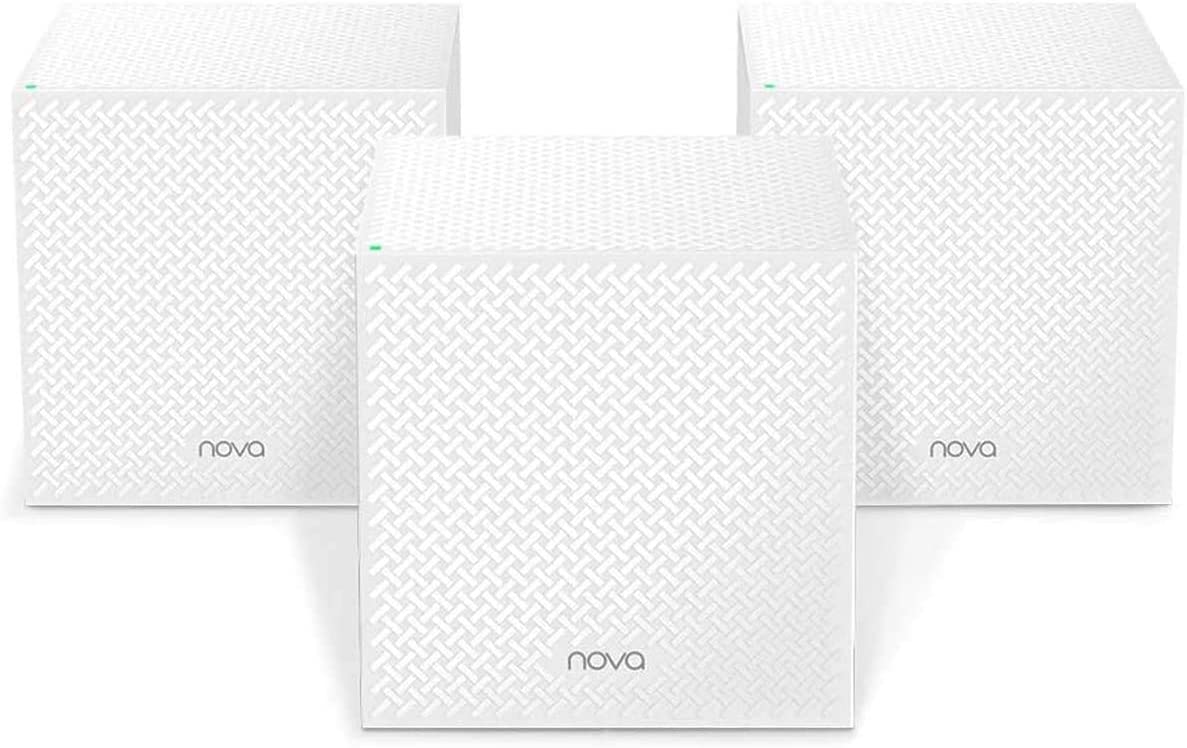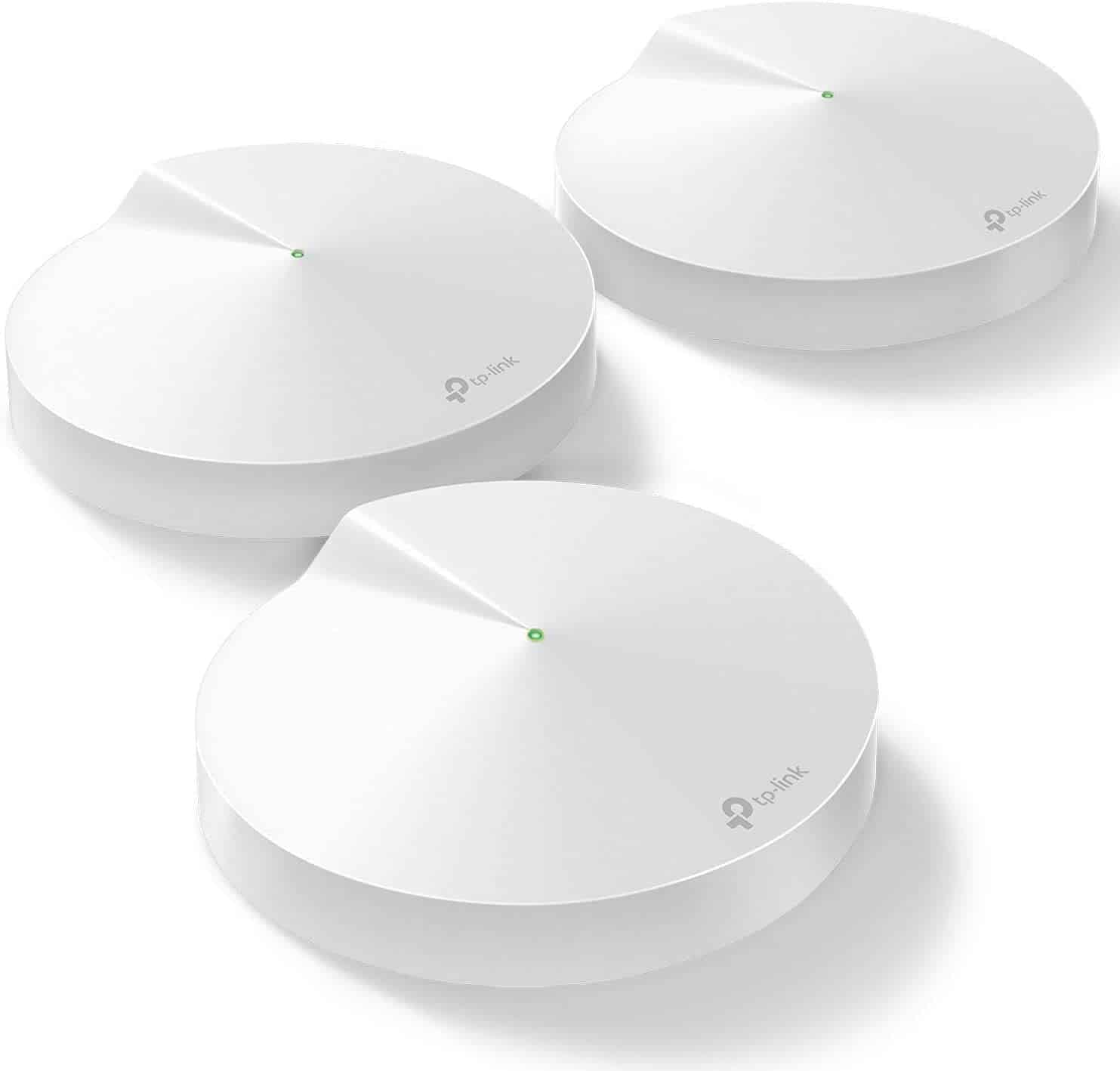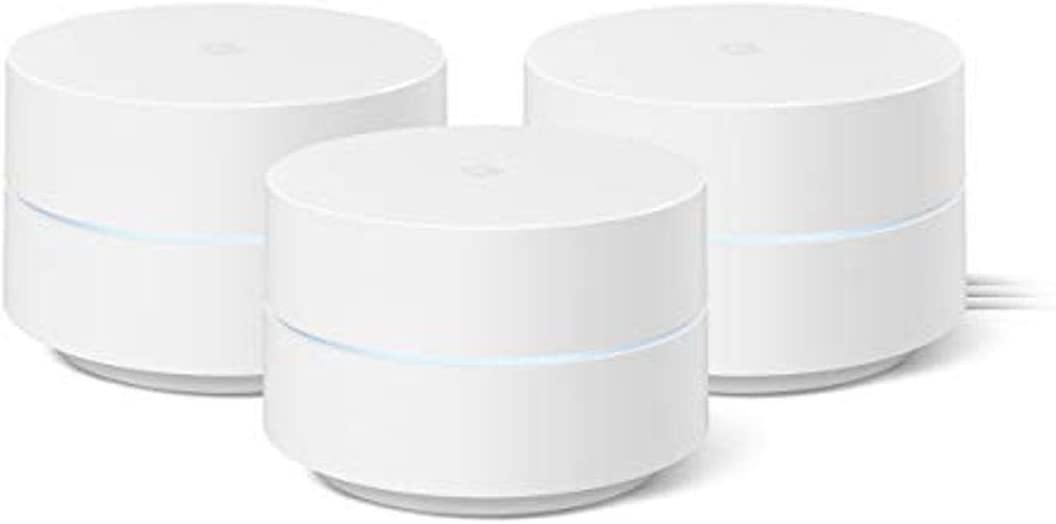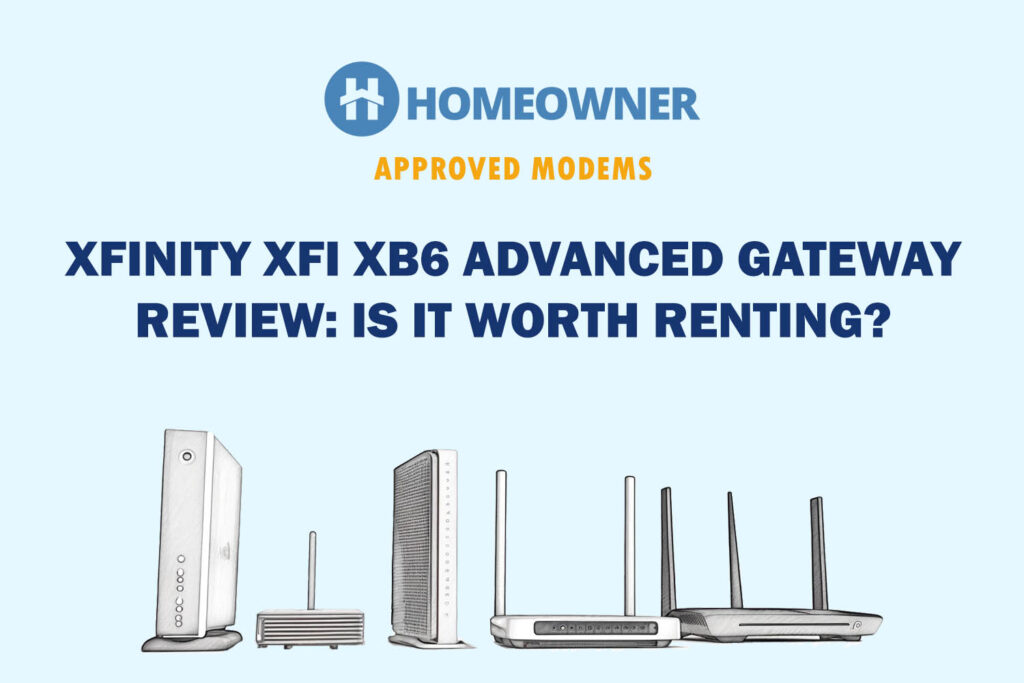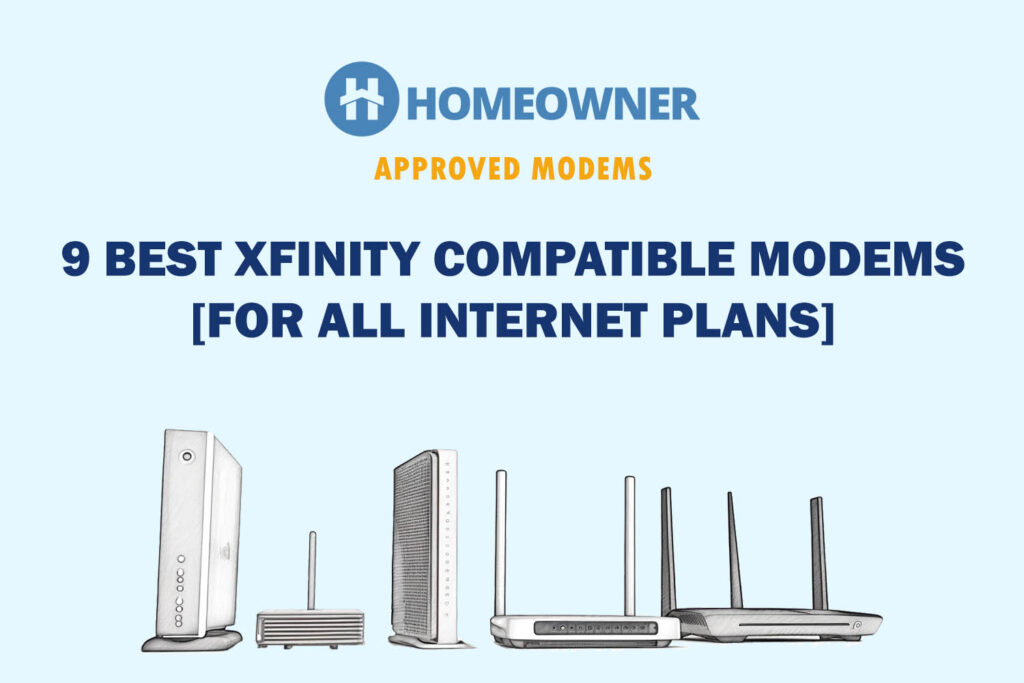In this post:
- 1. Best for Xfinity Gigabit: TP-Link Deco AXE5300
- 2. Best Runner Up: Netgear Orbi RBK752
- 3. Best for Gaming: Amazon Eero Max 7
- 4. Best for Thick Walls: Tenda Nova MW12
- 5. Best for Mid-Range Plans: TP-Link Deco M5
- 6. Best Budget Mesh WiFi: Google AC1200
- Factors to Consider when Getting a Mesh for Xfinity
- Frequently Asked Questions
- Verdict
Are you a Comcast subscriber who rents the xFi gateway for $14 monthly? Or are you having a separate modem and router setup? In either case, if you're facing low coverage or weaker signals at your home or workplace, you're better off establishing the Xfinity mesh network.
Finding a reliable mesh WiFi system for Xfinity can be difficult due to the many options available in the retail space. I was in the same dilemma a few weeks back, as even though the xFi gateway worked fine in my single-story test lab, it couldn't extend the coverage to the outside. And that's when I began the research for mesh systems.
Note: Every mesh WiFi system (even those not on the list) would work with any service provider, as mesh systems have no compatibility factor. However, since Xfinity is a cable-based service provider, you'll need a modem compatible with Xfinity, which will be connected to your mesh router.
During three weeks, I tested around 11 models while pairing them with different Comcast internet plans, and finally curated this list to simplify your buying decision.
Keeping all the possible pain points and user requirements in mind, I’ve thoroughly tested all 11 models under various circumstances. So, I promise that the below-listed 6 best mesh systems are great for Xfinity and shall deliver consistent WiFi signals, higher speeds, and effective performance throughout your large house.
Want to save money when buying your next mesh WiFi system? Checkout:
- EarnIn: Borrow up to $750 against an upcoming paycheck!
- Capital One Shopping: Automatically apply available coupon codes online to find deals and save!
1. Best for Xfinity Gigabit: TP-Link Deco AXE5300
Although TP-Link AXE5300 supports gigabit speeds, you'll need a modem capable of handling gig speeds. I used Arris S33 (one of the best modems for mesh WiFi) while testing this and the experience was quite smooth!
TP-Link Deco AXE5300 is a premium Xfinity compatible mesh router that justifies its price with features like tri-band operation, the latest Wi-Fi 6E standard, and myriad I/O ports, including a 2.5 Gbps LAN connector. And, it’s a substantial upgrade over the last model I used, Deco AX6600, in terms of speed, coverage, and performance.
Why is it suited for Xfinity?
When it comes to building a seamless mesh network for Xfinity, TP-Link AXE5300 is by far one of the best choices you’ve got. With the tri-band operation, it works well with most Xfinity internet plans, but it makes sense to achieve Gig-level speeds. I used this router with the Gigabit plan and wasn’t disappointed a tad with its performance.
The reason this device makes it to the top is its Smart Connect feature, powered by QoS. It helps automatically detect the purpose of network use and delivers the best possible speeds. So your laptops, gaming consoles, and cellphones are connected to 6 GHz and 5 GHz channels, while others are to a slower 2.4GHz channel. You can manually switch between bands if you wish to.
When connected to Xfinity’s gigabit plan, the maximum speeds for the 6GHz and 5GHz bands clocked at 1100 Mbps and 800 Mbps, respectively, while for the 2.4GHz band, it was 200 Mbps. Even moving far away from the mesh network didn’t fluctuate the speeds by much.
Aside from that, technologies like 2×2 MU-MIMO and OFDMA boosted the router’s overall performance, and I could perform bandwidth-intensive tasks like gaming, streaming, video conferencing, and others with ease.
Wi-Fi Coverage
AXE5300 has 8 High-Gain internal antennas, which boost the overall signal strength and cover areas up to 6000 Sq Ft. Beamforming combines several signals to deliver consistent WiFi. Plus, an additional 5 GHz band works exclusively for backhaul, further strengthening the range. So, irrespective of how many devices you’re connected to (max 120), there are no visible network lags.
Security & App Features
TP-Link has always emphasized the security of its users, and the Xfinity-supported mesh comes with a free HomeShield basic plan for basic network security scans and strong parental controls. You can use it to set website filters, monitor how long your kid is online, and the websites they are visiting and block any potentially age-inappropriate or malicious websites.
Apart from that, there are some advanced security features like DoS protection, malicious content filters, and network security reports.
Conclusion
With Deco AXE5300, you’ve got a well-equipped mesh WiFi 6E system with tri-band support to deliver solid throughput all the time. Some advanced security features and parental controls need a subscription, but there’s no price on security, right? So, overall you’ve got a reliable and efficient Wi-Fi 6 mesh system for Xfinity.
Pros
- Higher throughput
- Faster downloads & uploads
- Advanced security features
- Greater coverage
- 2×2 MU-MIMO and OFDMA
Cons
- Costly
2. Best Runner Up: Netgear Orbi RBK752
Netgear Orbi RBK752 is extremely fast and offers great coverage, making it one of the best Gigabit mesh and a good upgrade over RBS750. It ticks most of what we expect from a quality Xfinity mesh WiFi. Also, it offers myriad customization options, which lets you have total control over the device and the network.
Why is it suited for Xfinity?
Orbi RBK752 is a tri-band system with two 5GHz bands and a single 2.4GHz band in each node, so the connected devices won’t need to share bandwidth with backhaul traffic. So, there’s minimal network congestion due to boosted signal strength and, in turn, faster internet connectivity.
I tested the system with Comcast's Gigabit plan and was amazed by the speeds. The maximum speed for two 5GHz bands was 700 Mbps and 350 Mbps, respectively, while for 2.4GHz, it was as low as 100 Mbps. This is substantially low, but its 2×2 MU-MIMO assures that 5GHz band speeds are allocated to high-bandwidth tasks while the slower one is for tasks requiring lesser speeds.
If you want to experience greater speeds, connect your devices directly to the system through high-speed Gigabit Ethernet ports. I could play network-intensive games like Valorant, Destiny 2, DOTA 2, and others without any latency or visible lags.
Wi-Fi Coverage
The mesh system contains 6 internally housed antennas that extend network coverage to an area of up to 3,750 Sq Ft. However, rather than distributing signals and speeds across multiple devices at once, all of it is directed across the connected devices; this is known as beamforming. So, you get to make the most of your Gigabit plan and connect at least 25 devices simultaneously.
Security & App Features
You can easily set up and control the Orbi RBK752 using a free-downloadable and multi-platform Orbi app. Just plug in the router with the modem, sign into the app using the default username and password, and you’re ready to connect.
Furthermore, you can control security features like Netgear Armor and Netgear smart parental controls using the app. Turning the Armor on protects your network and data from unauthorized access, ransomware, and viruses. And using parental controls, regulate the number of hours your kids are active online, and block potentially explicit websites.
Conclusion
RBK752 is an ideal Comcast mesh WiFi for people hungry for performance and who wish to switch over from its previous model. Its dependable 5GHz backhaul channel ensures a smoother flow of data from the host to the receiver and includes security software, so your network and database remain clean and hacker-free.
You may also read my full Netgear Orbi RBK752 review to learn more.
Pros
- Tri-band setup
- Wi-Fi 6 support
- Malware protection
- Easy to setup & manage
- Excellent coverage
- Offers faster speed with top-tier plans
Cons
- Bulky
- Still expensive
3. Best for Gaming: Amazon Eero Max 7
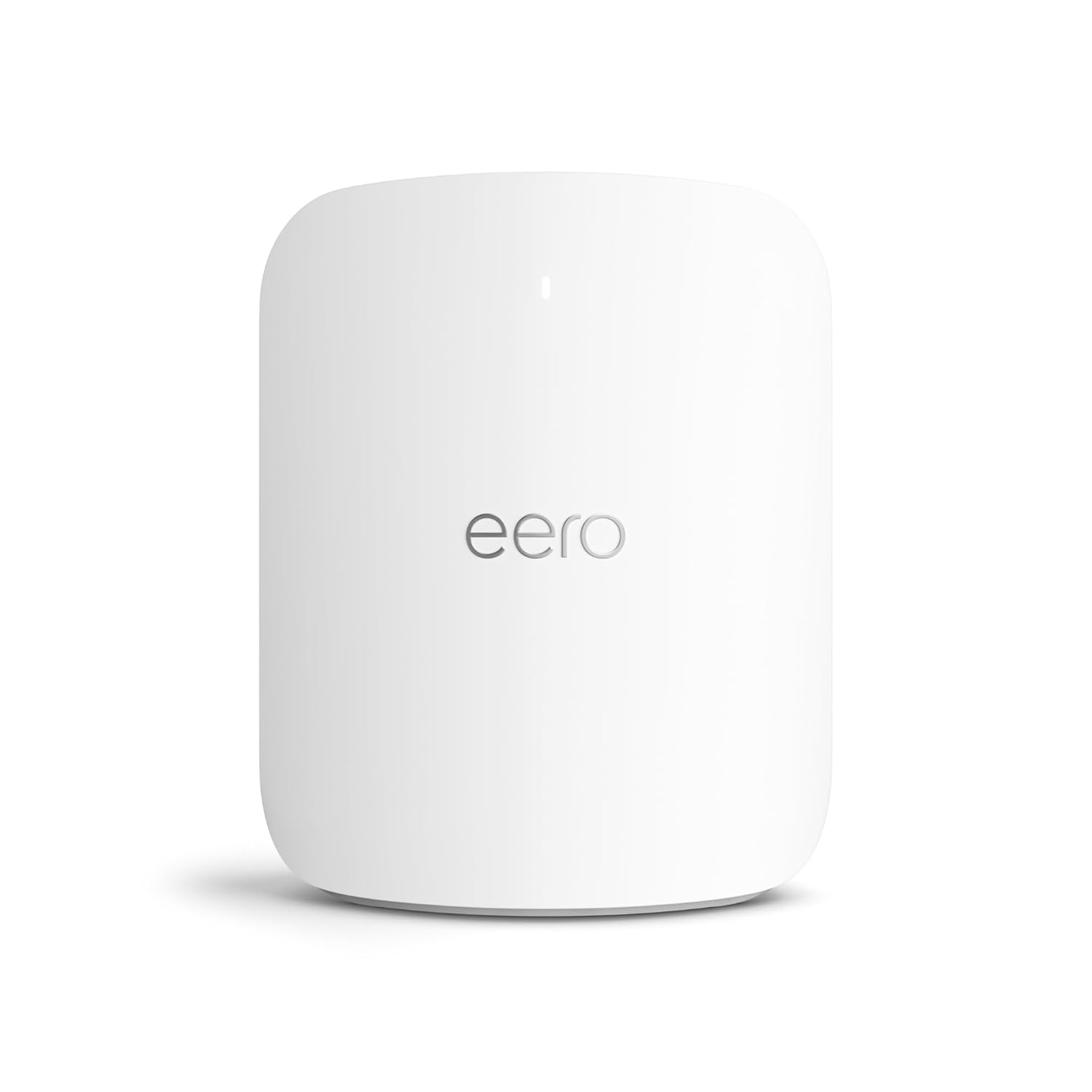
- Eero Max 7 (1-pack)
- 2 x 10 Gigabit ports
- 9.4 Gbps wired / 4.3 Gbps wireless
- Wi-Fi 7, TrueMesh, TrueRoam, TrueChannel
- Built-in smart home hub (Thread, Matter, Zigbee controller)
- 5,000 sq. ft. coverage, 500+ devices
The Eero Max 7 is one of the fastest mesh systems available and works well with Xfinity’s gigabit and multi-gig plans. It supports Wi-Fi 7, includes four multi-gig Ethernet ports, and keeps up with high-bandwidth activity like gaming, 4K streaming, and video calls.
You don’t get much control over network settings unless you subscribe to Eero Plus, but if you care more about performance and stability, this system delivers. The app setup is simple, the coverage is wide, and wired speeds are some of the best available in a mesh system.
Why is it suited for Xfinity?
Eero Max 7 works with Xfinity through standard bridge mode. I tested it with an XB8 modem on a 1 Gbps plan and had no trouble getting full speed through both wired and wireless devices. The system handled gaming traffic smoothly, even with multiple users online. On a wired connection using the 10 Gigabit port, I recorded 920 Mbps down and 950 Mbps up. Wireless speeds near the main unit reached over 800 Mbps on Wi-Fi 6E devices and stayed above 400 Mbps in rooms farther away.
If you want to use wired backhaul between units, it’s easy with the 2.5 and 10 Gigabit ports on each unit. That helps keep latency low and speeds consistent across the house. Even without gaming-specific tools like QoS settings or port prioritization, the system kept up with multiplayer sessions, streaming, and background downloads without slowdowns.
Wi-Fi Coverage
Each unit covers up to 2,500 square feet, and in testing, that range held up well. I placed one node near the Xfinity modem and the other in a far bedroom. Both units connected quickly, and the system kept speeds consistent through multiple rooms and a backyard area. There were no dead zones or sudden drops in performance.
I had over 40 devices connected, including consoles, phones, TVs, and smart home gear. The mesh handoff between units worked without delays, and devices stayed connected while moving around the house. Smart home compatibility is also built in, with support for Thread, Zigbee, Matter, and Alexa, so you don’t need extra hubs.
Security & App Features
The app is simple and fast. Setup took less than 10 minutes, and adding a second unit was automatic. You can see connected devices, pause internet access, set up profiles, and create guest networks. However, more advanced features like band control, content filtering, and threat blocking are locked behind the Eero Plus subscription.
If you’re just looking for basic controls, the free features are fine. But if you want to block apps, separate Wi-Fi bands, or view security reports, you’ll need to pay extra. That may be a drawback for users who prefer to manage everything without ongoing fees.
Conclusion
The Eero Max 7 is a very good option for Xfinity users who want fast speeds and reliable performance for gaming and daily use. It handles multi-gig wired connections, offers wide Wi-Fi 7 coverage, and keeps up with multiple devices without needing a lot of attention. The subscription limits some controls, but if speed, simplicity, and stability are your priority, this system works well with Xfinity’s fastest plans.
👉 Read the full Eero Max 7 review >>
Pros
- Fast wireless and wired speeds
- Simple setup with a helpful app
- Handles many devices with no drop in performance
- Built-in support for Thread, Matter, Zigbee, and Alexa
- Four multi-gig Ethernet ports
- Strong overall coverage with stable connection
Cons
- Key features locked behind a subscription
- Limited control over advanced settings
- Older 2.4 GHz devices can be tricky to connect
4. Best for Thick Walls: Tenda Nova MW12
Are you interested in a no-frills mesh WiFi that works with Xfinity to deliver reliable and efficient service without leaving a hole in your wallet? Then, Tenda Nova MW12 is a viable choice that offers better performance than the older MW6. So, let’s get into reviewing this mesh system in detail.
Why is it suited for Xfinity?
The mesh system stands out in terms of coverage and compatibility, which means you can use it to penetrate through thick walls while pairing it with any internet package. Being one of the standout Xfinity-compatible WiFi mesh systems, MW12 features Wi-Fi 5 tri-band support. Despite using an older Wi-Fi standard, the speed output of this networking device was pretty impressive.
The two 5GHz bands can deliver speeds up to 867 Mbps, while the maximum speed of the 2.4GHz band is 300 Mbps. Now, as far as real-time speeds are concerned, I received about 500 Mbps and 100 Mbps for respective bands with the Gigabit plan of Xfinity. So, running bandwidth-intensive activities like online gaming, 4K video streaming, and others with minimum latency.
Furthermore, features like AP steering and MU-MIMO boosts their overall performance. With band steering, you won’t need to manually steer between different bands to receive maximum speeds, but it surveys each band and activates one with faster speed output. Thereby rest assured, you can always experience the best internet services.
Wi-Fi Coverage
MW12 has four internal antennas, which work in unison to cover space up to 6000 Sq Ft and connect 50 devices simultaneously. And thanks to the beamforming support, you’ll receive the highest speeds every time on all your connected devices with high throughput, lesser latency, and minimal network disruption. As a result, you can extract the full speed out of your Xfinity’s Internet plan.
And unlike Eero 6+, there are three Gig Ethernet ports with which you can plug in your devices directly to access faster speeds.
Security & App Features
Your Xfinity mesh network stays secure courtesy of WPA2-PSK encryption. Basically, it safeguards your passwords and network against outside threats like hackers and cybercriminals. You and your friends can now browse the internet in a secure network zone without worrying about your privacy being compromised.
Aside from that, it entails parental control feature using which you can monitor the number of hours your kids are active and restrict their internet usage time.
Conclusion
To sum up, Tenda Nova MW12 is an easy-to-handle mesh WiFi suitable for Xfinity that works for high-speed office or home connections. I have installed this system in my small workspace connecting nearly 45 devices, and the experience has been pretty good so far. And its AP steering separates it from the herd.
Want to learn more about this mesh router? Read my full review of the Tenda Nova MW12.
Pros
- Three Ethernet ports on each unit
- Easy to use
- Compact design
- Faster speeds
- Pocket-friendly
Cons
- No Wi-Fi 6 support
5. Best for Mid-Range Plans: TP-Link Deco M5
TP-Link Deco M5 is another addition to my list of the best mesh routers for Xfinity that blankets your two-story house with solid wireless coverage. This system's major highlights include virus and malware protection, intuitive QoS option, robust parental controls, and easy installation.
Also, it delivers better speeds and coverage than the old Deco M4, which is compatible with 300 Mbps speeds or lower.
Why is it suited for Xfinity?
Deco M5 is made to use with mid-range internet plans, courtesy of dual-band Wi-Fi 5 support. Testing with Xfinity’s Blast, we found the unit to be much more focused on coverage than high throughput, but the connection was much stronger than it was with Deco M4.
Initially, I found a patchy throughput, but once devices were connected for a while, there was a massive improvement. On paper, the device claims to deliver the highest speeds of 600 Mbps, and the speed test results for respective 5GHz and 2.4GHz bands were 450 Mbps and 125 Mbps, respectively.
It might not sound that high, but I was quite content with how I could play online games at a maximum of 20-30ms ping. In layman’s terms, there was minimum latency and smooth gameplay.
The most exciting feature of this mesh system is the QoS presets, which allow you to allocate the bandwidth according to your tasks. For example, if you’re gaming, streaming 4K videos, and browsing Instagram, you could allocate the highest bandwidth for your gaming console and the lowest to the one running Instagram.
Wi-Fi Coverage
Deco M5 offers excellent coverage. I could cover nearly 3500 Sq Ft of a residential setting with a consistent Wi-Fi speed of more than 300 Mbps. Like most systems in retail, you can maintain a large space between the devices to expand the network coverage. However, greater coverage means lesser speed, so pick a balance you’re comfortable with.
Security & App Features
One aspect where TP-Link has tried and set itself apart from others is offering a one-stop solution in terms of security. You need to make a one-time purchase to Trend antivirus subscription and enjoy three years of limitless security. You put numerous confidential and sensitive information over the internet, which is kept from hackers or third-party attackers.
More than that, you also get parental controls to ensure the little ones aren’t accessing any explicit or age-restrictive websites. You can also pause the internet at any time for your kids to shift their focus on completing their homework.
Conclusion
The two standout aspects of this TP-Link Deco M5 are its price and ease of use. Individually it might not have grabbed my attention, but together they make a great combo, only to be let down by a slightly weaker throughput. It is why this mesh system is pushed down the list.
And if you want to learn more, check out the dedicated Deco M5 review.
Pros
- Reliable and fast Wi-Fi
- Protects your networks
- Decent coverage
- Budget-friendly
Cons
- No Wi-Fi 6
Alternative Product Suggestion:
Well, if you want better speeds and coverage by spending a few extra dollars, then TP-Link Deco X20 is an efficient alternative. With Wi-Fi 6, it’s compatible with Xfinity’s Gigabit plan and delivers a maximum speed of 700 Mbps.
6. Best Budget Mesh WiFi: Google AC1200
The days of getting an extender with your single router to fill the weak spots are finally over. Google brings you a 3-pack mesh system that’s fast, easy to install, and offers decent coverage. Priced less than $200, it’s one of the most inexpensive mesh systems to cover large homes.
Why is it suited for Xfinity?
The Google Wi-Fi matches well with Xfinity’s Blast! Drawing from most of the 600 Mbps internet service, I haven’t seen any router to deliver the same in this range. The mesh router can bring high performance throughout my house, albeit small.
Although the theoretical speed reports stand at 500 Mbps as the maximum, the real-time speeds aren’t very far away. At 5GHz, the speed clocked at 350 Mbps, while it was considerably less at 2.4GHz, i.e., 95 Mbps. Despite that, I could stream the final season of Witcher on Netflix in 4K quality and play Overwatch on my PS 4 without any issues.
The traffic prioritization feature of this mesh system ensures that your gaming consoles are receiving more of the critical bandwidth compared to other devices used primarily for streaming videos or browsing Facebook. Additionally, the network repairs itself automatically if any Wi-Fi points accidentally lose power.
Wi-Fi Coverage
Compared to the previous model, OnHubs, which came with a single unit, Google Wi-Fi has three, each known as a Wi-Fi point. Each point can cover up to 1200 Sq. Ft, the size of a small-sized apartment. And increasing the points or the set of three takes the overall coverage to 3000 Sq Ft.
When you install multiple units in your space, the first unit acts like an internet source and spreads it across several units to form a mesh network. Depending on the layout of your home, place your Wi-Fi points strategically at a distance apart to maximize the coverage.
This highly capable mesh system handles 60-70 devices running at a higher bandwidth simultaneously without any visible lags or latencies. My small workspace is running on Google Wi-Fi, where there hasn’t been a day when the employees complained about a weaker connection.
Security & App Features
Google Wi-Fi doesn’t come with one of those feature-packed apps, but it offers some helpful features for taking control of the mesh system. The app lets you configure the system with just a few taps, and you don’t need to be technically sound or be aware of the nitty-gritty of the process.
Other useful settings include continuous network monitoring, devices, and Wi-Fi points connected to it. Besides that, the app has an internet speed test feature that measures the health of your mesh connections and the overall network connection strength.
Among other things, the security features provided by the mesh system are also not top-notch. It supports WPA2 encryption, which is quite outdated but delivers a decent job of keeping your passcodes safe and secure. It lacks parental controls, and the only thing you can do is pause the internet connection on a specific device or multiple devices at once.
Conclusion
To sum up, Google Wi-Fi is an affordable yet efficient alternative to your single routers with which you can perform most of your bandwidth-intensive tasks with ease. However, as it lacks adequate security and parental controls, a desktop administrative interface, or a detailed settings menu, this system is placed at the bottom.
Pros
- Simple setup
- Excellent design
- Great value
- Decent speeds
Cons
- Lacks adequate security and parental controls
- Limited hardware control
Factors to Consider when Getting a Mesh for Xfinity
People often believe that renting gateways from ISPs is much better than purchasing one from third-party companies. $14 a month adds up to $168 per year, where-in you incur $120-300 upfront cost for a mesh system. Besides cost, these systems offer extensive coverage and much higher speeds than gateways.
The detailed reviews of the WiFi mesh systems for Xfinity might have given you an idea about what to look for. But, the path of purchasing a quality system is far from over, so I’ve prepared a curated checklist for what dictates a quality system. So here are the things you should look for when getting a mesh system for Xfinity.
- The best mesh system comes with dual or tri-band support running on 5GHz or 2.4GHz channels and sometimes uses 802.11ac wireless technology. The greater the number of channels, the higher the signal speeds and excellent coverage throughout your working space.
- Some of the best mesh systems integrate advanced technological features like OFDMA, MU-MIMO, beamforming, and others. Features like MU-MIMO and OFDMA allow streaming data simultaneously across multiple devices. On the other hand, Beamforming ensures the best wireless signals reach your home and, therefore, maximum throughput.
- The speeds of a mesh system mainly depend on the internet plans you’re using, so get yourself the best plans possible. However, thanks to mesh design and communication systems between routers and nodes, many top-tier routers support speeds up to 6 Gbps.
- Don’t forget to look into the number of Ethernet ports with the system. If you’re a gamer, connecting directly through the ports helps you attain unmatched speeds and a stable connection.
- The range of a mesh system must match the size and design of your home. However, the good news is that there’s always an option to add extra nodes to widen your internet coverage.
Frequently Asked Questions
Yes, it does. Most top-tier mesh systems work well with Xfinity internet plans to deliver faster speeds.
As far as my understanding goes, TP-Link AXE5300 is the best mesh system to work with Xfinity. The latest tri-band Wi-Fi 6E support works well with top-tier Xfinity plans to deliver incredible speeds and increased coverage.
Xfinity supports the latest Wi-Fi technology, including WPA3, Wi-Fi 6, and Wi-Fi 6E. So, to take advantage of this technology, ensure an ideal Wi-Fi device at your home.
Eero works perfectly well with Xfinity by Comcast. To configure your mesh system with Xfinity, bridge the wireless gateway by logging onto admin tools at and enabling bridge mode in settings.
Absolutely, Yes. A high-end mesh system offers many upgraded and advanced features than a traditional Xfinity modem router combo. It might cost a high upfront cost, but you might save a lot in the long term considering the high monthly rental of a company-provided gateway.
Verdict
That’s all there’s to tell you about some suitable mesh WiFi for Xfinity. I hope this helps you to make a viable decision. However, if you still are stuck, here are some of my recommendations:
- If there’s a need for a mesh system with top-notch features, including the latest tri-band Wi-Fi 6E support, technologies like OFDMA, 2×2 MU-MIMO, and others, TP-Link Deco AXE5300 is an optimal choice. It falls under the premium category of mesh systems but adds value if you aren’t concerned about the price.
- Next, if you need a reliable mesh router that delivers efficient and quality performance but doesn’t want to spend much, then Netgear Orbi RBK752 is a viable option. This Comcast mesh Wi-Fi boasts features like tri-band support, faster speeds, and decent coverage, making it suitable for most.
- And finally, if you’re looking for an entry-level device that’s easy to set up and performs fairly well, go for TP-Link Deco M5. It’s the cheapest option out there.
With that, goodbye and take care!


